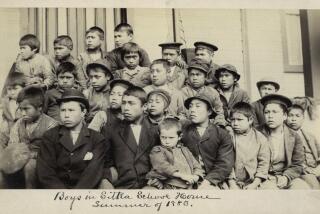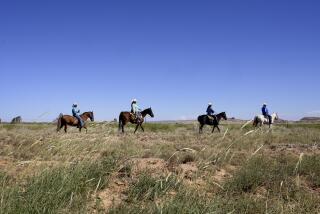Tribes aren’t quiet about language loss
PHOENIX — Several dozen children stand atop a bluff in Hualapai Mountain Park to face the morning sun as it peeks over a distant ridge.
“Nyims thava hmado we’e,” they chant, meaning “Boys greet the morning sun.” And then for girls: “Nyima thava masi:yo we’e.”
Jorigine Bender, the teacher, urges them to repeat the dawn greeting with raised hands. “Everybody, turn toward your brother, the sun.” The youths, Hualapai and Yavapai, recite the phrases in self-conscious, uncertain unison. The language is Pai, passed down through generations but unintelligible to the children.
With the United States dominated by computers, TV and video games, a decreasing number of Native Americans, especially younger ones, can speak or understand their native tongues.
The eroding fluency and the potential extinction of indigenous languages have prompted leaders of many tribes to develop immersion courses, such as this summer camp in the pine forest southeast of Kingman, Ariz.
Loretta Jackson-Kelly, historic preservation officer for the Hualapai Tribe, says there is hope that Pai will survive, but only if elders pass on their knowledge and children are willing to absorb it.
“A lot of people don’t realize the implications,” she adds. “Language loss means you lose your identity.”
There is no debate that native languages are becoming silent, one by one. There are differences only about how many will die and how soon.
According to the Indigenous Language Institute, only 20 of the 175 surviving American Indian dialects are expected to survive through 2050. Cultural Survival, an online advocacy group for indigenous bands, says 50 of the remaining native languages face imminent extinction because they have five or fewer speakers, all older than 70.
“It’s clear that the languages are disappearing,” said Leanne Hinton, professor emeritus in the linguistics department at UC Berkeley who spent years working with Pai-speaking tribes. “It’s also clear that, over the last 10 or 20 years, there’s a very strong effort to keep them alive or regain them.”
Lucille Watahomigie, a Pai linguist and member of the Hualapai Tribe, says the erosion is largely attributable to historical U.S. policies.
“It was like brainwashing, because when they were sent to Indian boarding schools, they were taught the language was wrong,” Watahomigie says. “It was that whole process of civilizing.”
After leaving government schools, many American Indians refused to speak their native languages at home in hopes that their children would compete better in a world dominated by English.
Watahomigie recalls her own experience as a first-grade teacher in the 1970s. Some students in her class could not understand the lessons in English, but she was ordered not to help them in Hualapai, one of the Pai dialects.
Watahomigie rebelled and persuaded the school to let her teach a bilingual class. By 1975, she had obtained a grant and was helping put Pai in writing for the first time.
By 1990, Congress had adopted measures encouraging bilingual education in native tongues. But decades of U.S. policies and the influence of pop culture had launched a seemingly irreversible trend. Tribal members who fail to learn their language at home seldom become fluent, experts say, and are unable to pass it on to their children.
In 2006, Congress passed the Native American Languages Preservation Act to provide funding for immersion courses. Jackson-Kelly, the Hualapai historic preservation officer, said she is relying on tribal contributions and volunteers for the summer camp.
Today, an estimated 40% of the 2,100 Hualapai tribal members speak the ancient language, but few of those are younger than 18.
The language decline is often more pronounced among smaller tribes living near cities, such as the 159-member Yavapai-Prescott Indian Tribe.
About 80 youngsters are camped in tents Hualapai Mountain Park. They rise at 5 a.m. for a hike, followed by language sessions. One “master” uses pantomime to teach a native game similar to street hockey, then asks kids to describe the actions in Pai. Others teach how to make arrows, gourd rattles and a drink from sumac berries.
Most kids embrace the lessons, though a few seem uninterested.
“I want to learn the language,” says Rivers Wilder, 14, of Peach Springs on the Hualapai Reservation, north of the park. “My grandma and my mom speak Hualapai. But it’s dying out. Most young people don’t know how to speak it and don’t want to learn. They’d rather play around.”
Ericson Pertevich, 10, also of Peach Springs, shrugs. “I just came here for the fun. I don’t really care too much. But sometimes I care because it’s like the tribe is going out.”
Because language frames the way a person looks at the world, Watahomigie says, its demise can threaten a tribe’s values, traditions and religion.
That reality is magnified by the dominance of pop culture.
“A lot of these kids here, they don’t even think they’re Indians,” Watahomigie says. “We have a lot of gangs, a lot of drug abuse right now. Much of that is because children don’t have a good self-concept. It’s important for them to be proud of who they are, to respect themselves, to understand that they are a unique people but also part of a whole.”
Nearby, two girls share an iPod. They appear to be ignoring their pottery instructor, but it turns out that the music in their ears comes from a traditional Hualapai singer.
Watahomigie says there is hope that modern technology can help save the ancient language but adds that the effort requires dedication.
“We have visions that there will still be the language a century from now. We have that truth,” she says. “But, being realistic, if things keep going the way they are, we won’t have any speakers.”
More to Read
Sign up for Essential California
The most important California stories and recommendations in your inbox every morning.
You may occasionally receive promotional content from the Los Angeles Times.










